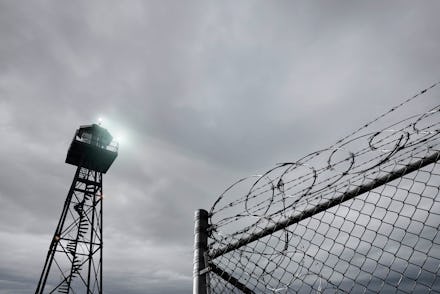One Appalling Statistic Sums Up Exactly What’s Wrong With America’s Prison System

Since 1990, crime rates have dropped 45%. But the incarceration rate jumped a whopping 222% between 1980 and 2012. Those are the findings of a major policy memo by the Brookings Institute and the Hamilton Project underlining America's economic costs of crime and incarceration.
The United States imprisons more people than any other country in the world — currently, state, federal and private prisons hold a combined 2.4 million inmates. However, the correlation between dropping crime rates and increasing incarceration rates is utterly enigmatic.
Ronald S. Sullivan, a clinical professor of law and director of the Criminal Justice Institute at Harvard Law School, explains the penal imbalance best by telling the Harvard Crimson, "the theory would be ... with the high rates of incarceration that the crime rate would go down and then that would be followed by less incarceration because there just wouldn't be as many crimes committed. But those numbers have gone in opposite directions."
There is good news: America's crime rate has dropped significantly. The FBI analyzed statistics of both violent crimes (like homicide and aggravated assault) and property crimes (like petty theft) over different periods in recent history. Between the '60s and '80s, there was a crime explosion for roughly 20 years. But between 1991 and 2001, crime rates dropped almost 30%, and between 2001 and 2012, those numbers fell another 22%.
Image Credit: Brookings
There are various interpretations that could be made here. One explanation is just that people are simply committing less crimes. Another is that criminals are spending more time in prison and less time on the street where they could re-offend, thereby lowering crime rates. Additionally, a heightened police presence, the fear of stricter and harsher punishments and the waning crack epidemic may also play pivotal roles in the crime rate plunge.
Here's the bad news: A $74 billion a year industry is locking up more and more people each year. "Academic evidence suggests that increases in crime cannot explain the growth in the incarceration rate since the 1980s," according to the Hamilton Project's policy memo. So if escalating crime rates are not the cause, what is?
Image Credit: Brookings
Sullivan points out that over-policing poor, minority neighborhoods could be one of the causes. Oftentimes, lower class defendants lack the resources to get out on bail or hire good attorneys and are therefore more likely to end up in the criminal justice system than people with the finances to defend themselves.
Another thought Sulluvan points out is that when the American penal system was created, rehabilitation was at its core. That's no longer the case. Sullivan says that now, "We look at incapacitation, we look at deterrence, and we look at retribution as goals that the penal system serves." Ultimately, if the end goal isn't to healthily reintegrate prisoners into society, then the system is unmotivated to hand out short sentences, oftentimes leaving people imprisoned for far too long.
Image Credit: Brookings
Why this matters: These statistics are history-making, but in all the wrong ways. If crime is down, the incarceration rate should go down as well.
To address this, the U.S. Sentencing Commission just passed an amendment that will radically reduce the average sentences for nonviolent crimes, which includes lesser sentences for drug traffickers. As marijuana legalization appears to be heading nationwide, the new amendment for nonviolent crimes is extremely apropos. Congress has until Nov. 1 to introduce and propose legislation to prevent the law from seeing the light of day. Hopefully, when this amendment passes, these topsy-turvy incarceration rates will see at least some improvement.